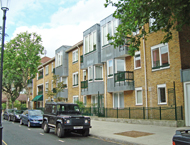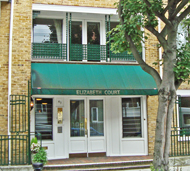Tuberculosis
On 14th May 1914 the Metropolitan Asylums Board (MAB) rented the Milman Street Receiving Home for Children, initially for two years, from the Westminster Board of Guardians to use as a sanatorium for women with advanced tuberculosis.
St George's Home opened on 11th June with 50 beds. Although intended solely for women, occasionally boys under the age of 16 years were also admitted.
The four floors each had a central corridor with rooms leading off it. In the basement were storerooms, the Maids' Sitting Room, the mortuary and the sputum disinfecting room. The ground floor contained three wards, the kitchen and administrative offices. On the first floor were five wards, Matron's room and the Nurses' Sitting Room. Staff bedrooms were on the top floor.
Seven of the wards had 6 beds each, while one ward on the ground floor contained 8 beds for ambulatory patients.
The mortality rate of the patients was high.
In 1916, 72 patients of 137 admissions died (53%); in 1917 some
88
of 175 (50%) died and, in 1918, 72 of 160 (45%).
In 1930, following the abolition of MAB, the Home was taken over by the LCC, who had long regarded the building as problematic as a Home. There were no grounds for the patients to enjoy the fresh air, just a paved courtyard. Similarly, with no dining room or recreation room, the patients had to spend all their time in their ward. There were also no single rooms for dying patients or for those with disturbing or disagreeable symptoms. With no bell system, in order to call the night nurse, a patient had to knock with her knuckles on her wooden locker.
By this time the Home had earned a reputation as a 'House of Dying' and patients had become reluctant to be transferred there from the London teaching hospitals while it was decided to which sanatorium to send them to complete their treatment (there was a 50% refusal). A policy was then implemented to admit fewer advanced TB cases and more milder ones with a definitive diagnosis for observation before onward transfer to a sanatorium. This worked well, although there was always a danger that a patient would be returned to the Home by the sanatorium as being 'too advanced', leading to the patient's despair at this death sentence.
Patients stayed at the Home for 4 to 5 weeks before onward transfer. In 1932, of 437 patients admitted, some 374 were sent to a sanatorium, 42 to a general hospital, 19 had discharged themselves and 2 had died. In 1933, of 496 patients, 434 went to a sanatorium, 30 to a general hospital, 29 had discharged themselves and 3 had died.
During WW2 the Home joined the Emergency Medical Scheme. It closed in October 1940 because of bomb blast damage, but re-opened on 2nd February 1942.
After the war, in 1945, the Home had only 24 patients as beds had to be closed due to the lack of cleaning staff (there were only 2 of the complement of 6 - husbands were reluctant to allow their wives to work in TB hospitals because of the danger of infection). The nursing staff, however, was at full strength - with a Matron, a Sister, 2 Staff Nurses and 10 Assistant Nurses. Nurses were X-rayed every six months, but not Mantoux-tested.
Arrangements had been made for patients to go to St Stephen's Hospital for chest X-rays (but these were often over-exposed and so of poor quality), while their pathological specimens were sent to St Mary Abbots Hospital.
In 1948 the Home joined the NHS under the control of the Chelsea and Kensington Hospital Management Committee, part of the South West Metropolitan Regional Hospital Board. It had 51 beds.
The Home closed in 1956.
Present status (August 2008)
In 1956 the LCC bought back the building for use as a hostel until the 1980s. It was then demolished for new housing.
Its site on the corner of Milman's Street and Moravian Place is now occupied by Elizabeth Court.


Elizabeth Court.
www.aim25.ac.uk
www.british-history.co.uk
www.englishheritagearchives.org.uk
www.viewfinder.english-heritage.org.uk
www.workhouses.org.uk
Return to home page